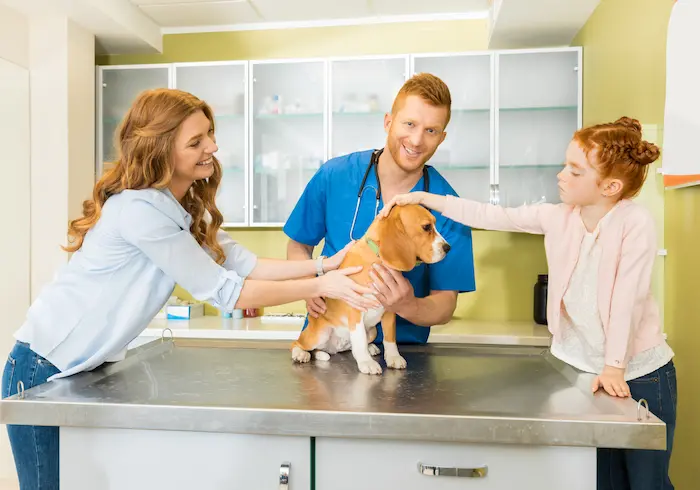Deciding to neuter or spay a dog is one of the most important steps you can take as a dog owner. Both procedures are the surgical removal of reproductive organs, and it’s something many pet owners do quite quickly when they adopt a new dog. Having a dog spayed or neutered doesn’t just help prevent unwanted puppies; it can also offer health benefits and may have behavioral benefits too.
Why Spay or Neuter a Dog?
There are many reasons pet owners choose to have their dogs spayed or neutered. According to a study published by the University of Georgia, spayed females live 26.3% longer than unspayed ones, and neutering male dogs extends their life expectancy by 13.8%. Unspayed dogs are at increased risk of a variety of health conditions, and spaying can sometimes be an effective treatment for health issues in older dogs.
While it’s true that spaying and neutering are surgical procedures that shouldn’t be taken lightly, they offer several benefits, including:
- Avoiding unwanted pregnancy
- Stopping heat cycles and the associated erratic behavior, including:
- Fearful elimination or urinary incontinence
- Roaming
- Excessive yowling and barking
- Aggression
- Reducing the risk of certain cancers and other health conditions, including:
- Testicular cancer
- Ovarian cancer
- Breast cancer/mammary cancer
- Uterine cancer
- Uterine infection
Whether you have a male or female dog, as a pet owner, you have a responsibility to help avoid unwanted litters. Pet overpopulation is a serious issue. If you’re not certain your pet’s environment is right for raising more puppies or that your female dog will be able to carry healthy puppies, ask a veterinarian about spaying her. This is especially important if she had behavioral issues during her first heat cycle or spends a lot of time with other dogs.
When Should You Get a Dog Spayed or Neutered?
In the past, dog owners were advised to have their dogs altered while they were still very young. The standard advice was to treat all dogs before they were 6 months old. More recent research suggests this one-size-fits-all advice may not be suitable for every situation. There could be long-term health risks to spaying large-breed dogs too young.
The best time to spay or neuter small-breed dogs is when they’re around 9 months old. Some pet owners consider delaying spaying because they’re worried about the surgery causing health issues. Spaying a small dog before its first heat cycle is likely to have a protective effect in terms of some cancers.
If your dog has good veterinary care, she’s more likely to benefit from spaying than experience complications. If you have a large-breed dog, it’s best to wait until she’s fully grown before having surgery done to allow the growth plates to fuse, preventing excessive bone growth and avoiding increased risks of bone cancers and joint disorders later in life.
What Happens During This Surgical Procedure?

Both spaying and neutering are performed under general anesthesia. You’ll usually be asked to avoid feeding your dog before it’s given an anesthetic. Before the veterinary team performs the procedure, it will carry out a full physical examination of your pet.
How Neutering Works for a Male Pet
Neutering a male dog involves a procedure known as castration. Both testicles are removed, taking away the primary source of testosterone, which is one of the most important reproductive hormones.
How Spaying Works for a Female Dog
Spaying refers to the removal of female reproductive organs. Spay surgery usually involves the removal of the ovaries and uterus. The term veterinarians use for the spay procedure is ovariohysterectomy. In some cases, vets remove just the ovaries, leaving the uterus intact.
Performing the Surgery
The vet will clip the hair around the surgery site, then make a small incision so they can reach the target organs. They’ll also use an intravenous catheter and breathing tube to provide fluids and help keep the airways clear. Some veterinary clinics will offer the option of keyhole spay surgery for female dogs.
These procedures are performed at a veterinary clinic, but they’re not inpatient procedures. Most dogs recover from the surgery quite quickly and can go home the same day.
What Happens After the Procedure?
Some veterinarians prescribe pain medication to help with recovery. Drugs such as Rimadyl can help control pain while the surgical wound heals. To prevent complications, it’s important to keep the wound clean and dry. Keep your pet away from other animals and encourage it to rest.
The Side Effects of Neutering or Spaying
Neutering is a surgical procedure that’s carried out under general anesthesia. This means it’s not completely risk-free. However, complications are rare. Your pet may gain weight after being spayed or neutered, but this isn’t guaranteed to happen.
In general, younger dogs recover from spay surgery quite quickly. Risk factors can vary depending on the specific breed of your dog and whether she has any preexisting health conditions. If your dog has a knee injury or is sedentary for other reasons, there may be some increased risk of weight gain after spaying her. Ask your vet for advice on how to prevent obesity.
Early spaying of large-breed dogs could lead to complications when they’re older. However, if you follow your vet’s advice and spay your dog at the right age, you’ll be protecting her from a variety of potential health problems later in life.
Spaying is sometimes recommended as part of the treatment for a life-threatening infection called pyometra. This is one of many types of uterine infections that female dogs are at risk of developing. A second surgery may be recommended if they already had one that removed only the ovaries. Spaying a dog with pyometra is a higher-risk procedure than spaying a healthy dog.
Other Things Pet Owners Can Do to Keep Their Pets Safe
Spaying or neutering a pet is just one of many things pet owners can do to keep their dogs safe. At Halo Collar, we’re passionate about keeping dogs safe and healthy while giving them the freedom to exercise and have fun in the open air.
The Halo Collar is an innovative training aid that helps you keep your dog within a certain area. Think of it as a wireless fence that lets you configure the boundaries. Your dog can play fetch, run or walk freely within that area, and when it reaches the boundaries, it’ll be guided back to safety. The Halo Collar is for dogs aged 5 months and over, so it’s a handy way of keeping large-breed dogs that aren’t yet altered out of mischief.










